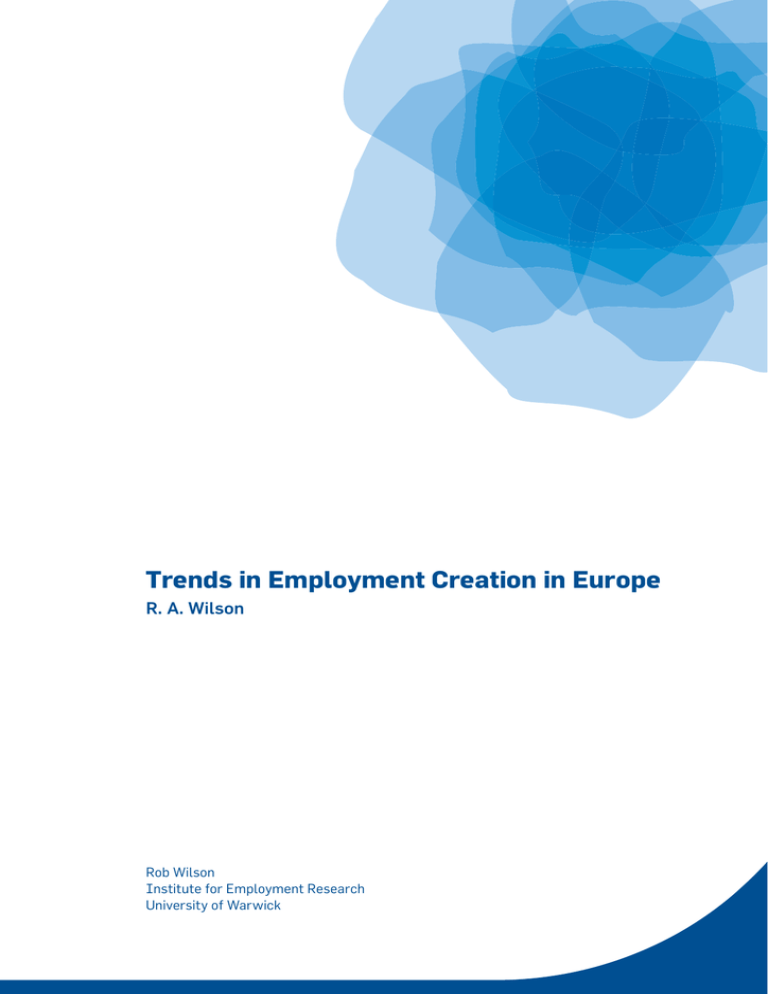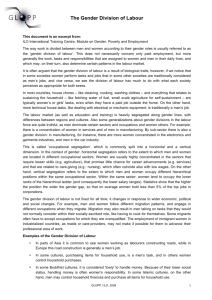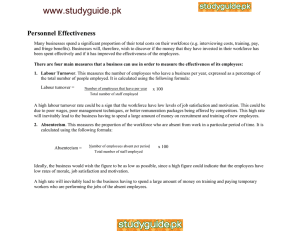Trends in Employment Creation in Europe R. A. Wilson Rob Wilson
advertisement

Trends in Employment Creation in Europe R. A. Wilson Rob Wilson Institute for Employment Research University of Warwick Trends in Employment Creation in Europe R. A. Wilson 1. Background Climate change, globalisation, technological change and demographic developments (including ageing and migration) are posing huge challenges, offering both threats and opportunities for the EU. This paper considers trends in job creation in Europe over the recent past, and the prospects over the next two decades, in this context. It draws upon the Cedefop project on Medium-term forecasts of occupational skill needs in Europe.1 This offers for the first time a Pan European perspective, providing estimates on a consistent basis for all members of the EU. The Cedefop project uses a combination of data sources to measure employment structure in Europe in a common framework. The numbers presented by sector are based on consistent data from Eurostat (National Accounts basis), while the information on occupational structure relies on LFS based estimates. This analysis is summarised below. Before examining these results it is useful to set the scene in terms of the main labour market challenges facing the EU. 2. Key labour market challenges facing the EU Skill biased technological change has resulted in the overall demand for skills rising rapidly in recent years and these trends seem likely to continue. Rising skill levels are expected in most sectors and occupations. The key drivers affecting the demand for and supply of skills are globalisation, technological change and demography. Since the setting of the Lisbon Agenda, the EU has seen considerable improvements in its economic and labour market position but much remains to be done. The EU economy is in a stronger position than it was a few years ago. It ranks in the top three in the world by level of GDP. Productivity has continued to rise but there are still significant gaps compared with best practice in the rest of the world (as well as between member States). The qualification and skill profile of the EU workforce has also improved (see Figure 1). The proportion of the labour force without qualifications has fallen: many more people are acquiring higher level qualifications, and far greater numbers are employed in higher level occupations (managers, professionals, and associate professionals). However, other competitors have improved at even faster rates, and a large proportion of the EU workforce remains poorly qualified. The two main challenges facing the EU labour market are intensifying international competition (resulting in the need to increase productivity) and social exclusion. Both of these can be addressed by appropriate investment in skills, although this is not a panacea. A number of features are apparent in the skills arena: 1 For further details see Wilson, R.A. (2007). The Skillsnet project on Medium-term forecasts of occupational skill needs in Europe: an overview, paper presented at the, 3RD TECHNICAL WORKSHOP, May 7-8 2007, Maastricht, Netherlands. (Event organised within the framework of Cedefop’s international network on Early identification of skill needs “Skillsnet” (www.trainingvillage.gr)). 41 • The pace of change in technology, globalisation is accelerating with implications for changing patterns of employment by sector and skills. • Many existing skills will become obsolescent – there is an urgent need to look at the upskilling and retraining needs of the current workforce. • Structural and occupational change, technological and demographic drivers will, in combination, continue to increase the demand for higher level skills. • The need to replace skills will continue to fuel demand for low-skilled and semi-skilled occupations in sectors such as manufacturing and construction. • The need for good technical skills (as well as “employability” skills) remains a key driver of many skill shortages. • Many adults still have basic literacy and numeracy problems. Figure 1 - The supply of skills in the EU is improving Sum of weight 120,000,000 100,000,000 80,000,000 60,000,000 40,000,000 20,000,000 0 1. Low 2. Medium 3. High missing qualification year: 2000 2003 2005 Source: Own estimates bases on Eurostat EU Labour Force Survey Microdata set. Figure 2 - Changing balance in the world economy Shifting shares in global output (Purchasing power parity) India 6% G7 49% India China 3% 3% Brazil 4% Russia 5% Other 36% 1980 India 7% China 19% Brazil 3% Russia 3% China 13% Brazil 3% Russia 3% G7 42% Other 33% 2004 G7 36% Other 32% 2015 Areas indicate size of global economy. Source: IMF, Consensus Forecasts, HM Treasury. 42 3. Changing balance in the world economy The “centre of gravity” of the world economy is shifting eastwards (see Figure 2). China and India in particular are likely to become an even larger force in world economic events over the next few decades. This will pose both threats and opportunities for the EU. Adopting a “siege mentality” is likely to be counterproductive and inhibit the changes necessary. This is associated with the mistaken belief that China and other developing economies can only grow at the expense of domestic jobs and prosperity, and that the only way to save local jobs is by adopting protectionist trade policies. The emphasis needs to be on creating more new “good” jobs rather than protecting old “poor” ones. 4. The Demographic Challenge Demographic changes, notably the increase in the average age of the EU’s population, with implications for dependency rates and pressures on pension and health systems (as well as public finances), will add to the external pressures and make it more difficult to attain productivity and growth targets (see Figure 3). The declining numbers of young people entering the workforce will lead to a greater reliance on older workers, and will increase the need to look beyond the current employed workforce, for example, attracting new migrants, and increasing the employment rate by moving people from benefits into work, etc. Figure 3 - Demographic changes Population in EU25 aged 15 to 24 and 55 to 64, 2005-2030 (in million) 70 _by 2030 65 + 14 million 55-64 years olds 60 55 50 45 40 2005 -9 million 15-24 year-olds 2010 2015 2020 2025 2030 Source: Population projection 2004, Eurostat, baseline variant. 5. Pan European Employment Trends in Job Creation: Initial Results from the Cedefop Project on anticipating future skill needs The new employment projections emerging from the Cedefop project remain preliminary, and the detailed results are likely to be subject to amendment before the publication of the final results at the turn of the year. There is also considerable scope for further refinement and improvement of the methods used. Despite these reservations, many of the results emerging from the analysis are robust and not sensitive to these detailed concerns. Such projections can provide valuable information to a broad range of users, from individuals 43 making career choices through to policy makers operating at the highest strategic level, about the changing patterns of job creation within the EU. They offer for the first time a broad and consistent overview for the whole of Europe, providing a common Framework within which prospects for individual countries can be compared. This section presents a summary of the results, summed across all 25 EU countries (i.e. for the whole of Europe as of the end of 2006). The results at the level of 6 broad sectors follow a similar pattern for most individual countries, although the significance of the different sectors obviously varies quite significantly across countries. Some common themes emerge in terms of changes over time, notably the declining shares of those employed in primary and manufacturing sectors and the growth of employment in services (both marketed and non marketed, see Figure 4). Similar information is available for more detailed industry breakdowns, and here the differences across countries are greater. Trends by broad occupation (9 groups) reveal a steady increase in the number of jobs at the upper end of the occupational/skills spectrum (see Figure 5). Again analogous information is available for a more detailed 27 category breakdown. There are many trends in common across countries at this broad level of aggregation. However, there are also some differences, especially at the more detailed level of aggregation. These reflect different stages of economic development and different industrial & occupational structures. The Cedefop project also includes more detailed results by sector and by occupation, as well as those which compare across countries. The latter highlight the relative sizes of the 25 countries in terms of total employment, as well as overall trends in each case. It is clear that, even at the broad levels shown here, there are some significant variations across countries but the overall trends shown here are quite robust, with many common themes. Figure 4 - Past and Likely Future trends by Sector (EU 25) thousands 70,000 60,000 50,000 40,000 30,000 20,000 10,000 0 1995 2000 2005 2010 2015 2020 Primary sector & utilities Manufacturing Construction Distribution & transport Business & other services Non-marketed services Source: Preliminary estimates from the Cedefop project based on the CE E3ME Model. 44 2025 Figure 5 - Past and likely future trends by occupation (EU 25) thousands 50,000 45,000 40,000 35,000 30,000 25,000 20,000 15,000 10,000 5,000 0 1995 2000 2005 2010 2015 2020 2025 Professionals Clerks Skilled agricultural and fishery workers Plant and machine operators and assemblers Legislators, senior officials and managers Technicians and associate professionals Service workers and shop and market sales workers Craft and related trades workers Elementary occupations Source: Preliminary estimates from the Cedefop project based on the CE E3ME Model. 6. Replacement demands In addition to analysing changes in overall occupational employment levels it is important to consider replacement demand. Replacement demand focuses on job openings arising because people leave the workforce, due to retirement, net migration, movement into other occupations and in-service mortality. Replacement demands for a particular occupation depend on the scale of employment in the occupational category and the rate of outflow (which can in principle be separated out to distinguish the various elements as described above). A simple set of assumptions has been used to generate these estimates. These are not at present country specific. Outflow rates will depend upon the age structure of the particular group of workers (defined by country, industry and occupation), as well as other specific factors such as mortality, etc. Not least amongst the latter will be factors relating to migration flows between countries. These have become of much greater significance in recent years. While the general Framework developed in the Cedefop project allows for these differences to be taken into account, its application in these preliminary results adopts a much simpler set of assumptions. The present set of results (see Figure 6) should therefore be regarded as illustrative. They are based on the assumption of a rate of outflow of around 2 1/2 % per annum. It excludes migration. The latter is probably a major factor for some countries. 45 Figure 6 - Replacement demands (EU 25, (000s)) All industries 721 79 Armed forces 17,668 Legislators, senior officials and managers 5,275 21,841 Professionals 3,664 32,175 Technicians and associate professionals Clerks 12,699 12,423 -4,868 22,637 Service workers and shop and market sales workers 6,569 6,637 Skilled agricultural and fishery workers Craft and related trades workers -1,388 14,857 -3,668 13,740 Plant and machine operators and assemblers 1,622 22,461 Elementary occupations 9,443 -10,000 0 10,000 20,000 Expansion demand 30,000 40,000 Net requirement Source: Preliminary estimates from the Cedefop project based on the CE E3ME Model. Figure 7 - Shift towards an “Hour glass” Occupational Structure Changing Occupational Structure (EU 25) Armed forces Legislators, senior officials and managers Professionals Technicians and associate professionals Clerks Service workers and shop and market sales workers Skilled agricultural and fishery workers Craft and related trades workers Plant and machine operators and assemblers Elementary occupations 0,0 5,0 10,0 15,0 20,0 Per cent 1994 Source: Preliminary estimates from the Cedefop project based on the CE E3ME Model. 46 2004 2014 7. Polarisation: the “hour glass effect” It has been argued by some that technological change and globalisation have resulted in a polarisation of the demand for skills. While skill biased technological change has increased the demand for many higher level skills, there has at the same time been growth in demand for less skilled jobs, and a hollowing out of the occupational spectrum, creating an hour glass shaped structure. The initial results emerging from the Cedefop project tend to confirm this picture (see Figure 7). There has certainly been some hollowing out of the occupational spectrum, with the loss of employment shares amongst agricultural and fishery workers, some other craft workers, clerks and other intermediate level jobs. Moreover, especially when replacement needs are taken into account, there will be many job openings at the elementary and less skilled levels (see Figure 6). There are of course also other important aspects of polarisation, including geographical dimensions (some areas benefiting from economic growth much more than others), as well as issues related to “flexicurity” (temporary versus permanent employment contracts, etc). 8. Caveats on the projections It should be emphasised that the projections are not prescriptive. They are the consequence of extrapolating past patterns of behaviour and performance. They are not inevitable, but likely if nothing else changes. The trends at aggregate level are quite robust and subject to considerable inertia. They represent the effects of powerful “economic tides” that will be difficult if not impossible to resist. The priority will be to educate, train and inform EU citizens so that they can “surf the waves” rather than trying to resist them. The Lisbon agenda and subsequent policy statements from the EU Commission have emphasised the need for Europe to anticipate changing skill needs. The need for regular forward looking assessments has received further impetus following the setting of employment targets and related policies as part of the Lisbon Strategy. Such results can help to inform active labour market policies to retrain the unemployed or reintegrate individuals who are economically inactive. It is also becoming increasingly important given the rising levels of migration flows between countries. Labour mobility between European countries is, if anything, likely to increase further. International labour mobility can help to resolve labour market bottlenecks and deal with surpluses. Information on future skill needs in Europe can help, therefore, to orientate and guide policy, as well as informing individuals about the developing situation. Whilst it is generally accepted that in a market economy it is not possible to predict the future precisely, the need to make strategic plans and choices which will influence the future path taken by the economy and labour market is widely accepted. Such plans need to be guided by robust labour market information and intelligence (LMII), including a forward looking element. This needs to be based on regular, systematic and quantitative approaches to forecasting and scenario development. Skills are a key part of the infrastructure of the economy, and the choices made by both policy makers and individuals about investment in education and skills will help to determine the path the economy takes. These choices need to be guided by good LMII. Currently the EU is only investing modestly in such activities. Comparison with our main competitors suggests the need to give such work much higher priority. A range of approaches to assessing future skill needs is required. These need to encompass both quantitative and qualitative methods and to serve a range of audiences, including: policy makers, stakeholders, social partners, practitioners and individuals. 47 9. Why Skills Matter It is important to remember why skill matter. There is a growing body of evidence that demonstrates the financial benefits of education and training. Across the spectrum from higher degrees to more basic investments in literacy and numeracy, individuals gaining additional skills and qualifications see a significant return on their investment in terms of future earnings, (see Figure 8). There is also evidence that performance of companies and the prosperity of individuals are both dependent upon the skills they possess. Investment in education and skills also has considerable benefits in terms of increasing employability and reducing social exclusion (see Figure 9). Research undertaken as part of the Leitch review in the UK, has examined the returns to investment in different skill levels. While there are likely to be significant positive returns to investment in skills at all levels (see Figure 10), there are very different implications for equity versus efficiency (see Figure 11). Investment in higher level skills (i.e. at university degree level+) is more important for efficiency and achieving productivity gains, while investment in more basic skills (especially literacy and numeracy) is more important to achieve better social inclusion and equity. Figure 8 - Pay and Qualifications Hourly pay of adults by highest qualification Working age population (per cent) 100% 80% 60% 40% 20% 0% No qualification Below level 2 £0-4 per hour Level 2 £5-9 per hour £10-14 per hour Level 3 £15-19 per hour Source: Skils in the Global Economy, HM Treasury, 2005, p11, derived from Labour Force Survey, Winter 2003 48 Level 4+ £20+ per hour Figure 9 - Social inclusion- Economic activity rates by level of qualification 100% 80% 2 4 6 52 60% 17 20 24 33 7 74 6 40% 76 81 ISCED 5 ISCED 6 70 61 Inactive Unemployed Employed 3 42 20% 23 0% ISCED 0-1 ISCED 2 ISCED 3 ISCED 4 Source: Own estimates bases on Eurostat EU Labour Force Survey Microdata set. Figure 10 - Possible returns from future investments in skills Annual net benefict and benefict-cost ratios 5 4 3 2 1 0 Tackling low skills Improving intermediate skills Constant wage returns ( £ bilion) Wage returns fall ( £ bilion) Focusing on high skills Benefict-cost ratio Source: Leitch Review Figure 11 - Efficiency versus equity 0.3 1.5 0.2 1.0 0.1 0.5 0.0 0.0 Tackling low skills Improving intermediate skills Employment rate (LHS) Source: Leitch Review 49 Focusing on high skills Output per worker (RHS) per cent Percentage points Impact on employment and productivity on top of current ambitions by 2020 10. Policy implications 1: Addressing skill gaps and investing in skills The overall demand for skills is projected to continue to rise. While there have been improvements in European skill levels other competitors have not stood still. There are a number of significant skill gaps, which need to be addressed. More emphasis is needed on: • adults and basic skills –a key problem remains the poor skills of many of those already in the workforce; • vocational as opposed to academic qualifications; • focusing a significant proportion of post 16 training activity on meeting future skill needs. There is a real concern about the share of students going into Science and Engineering courses. The “knowledge triangle” (education, innovation and research and development) requires a sound science, technology and engineering foundation if the EU is to compete successfully, and this requires high level skills in this area. Other aspects such as innovation and design in the more creative and cultural industries and services will also be very important, as will a large range of jobs associated with the care of the environment and care of people. There is a need for further improvements in labour market information on current and anticipated future changes to assist in tackling these problems by making people better informed. In particular, these need to address the failure to recognise: • the full benefits of education and training; • the value of vocational as opposed to academic routes; and • the significance of replacement demands as opposed to net changes in employment levels. Perhaps the most difficult challenge of all will be to raise the demand for skills from employers. Unless they can also be persuaded to recognise the benefits of skills, and to invest more heavily in them, then supply side intervention is likely to be ineffective, resulting in skill surpluses rather than the well paid highly productive jobs that are likely to characterise a successful 21st century economy. This may require “sticks” as well as “carrots”. There has been much talk of raising sights and ambitions but there are few policy levers to achieve this. Ways of raising standards might include: • Increasing or introducing minimum wages; and • Introducing Licences to practice across Europe. Employer engagement, diagnosis and response are crucial - (greater sectoral involvement, taking into account the particular circumstances of SMEs, measures to change reporting incentives, to encourage investment in skills, etc, are all needed). There is also a need for more and better policies to engage learners (better LMI, careers guidance, entitlements, licences to practice). Finally, it is important to get the balance right between equity and efficiency, but investment is needed across the spectrum. 11. Policy Implications 2: The need for better Anticipation It is not possible to predict the future precisely - mechanistic skills forecasting is infeasible in a market economy. But individual actors need to make strategic plans and choices which will influence the future path taken by the economy and labour market. Preparing the workforce for these challenges requires robust LMII, including projections. The present EU infrastructure in this area is inadequate compared 50 with our main competitors. The EU currently devotes only very modest resources to such activities compared with the much higher investment in Anticipation being undertaken by the US (Bureau of Labor Statistics, $6-7 million per annum), and in countries such as China. Anticipation is a key element in 3 of the EU Employment Guidelines: • #19 (improving matching of labour market needs); • #20 (promotion of flexibility and adaptability); • #23 (adaptation of education and training systems to meet new requirements). If this issue is to be taken seriously a significantly greater share of resources needs to be allocated to this kind of work at EU level to develop a sound infrastructure to serve the whole EU (to complement the efforts being made by some individual countries). A variety of approaches is needed, but regular, systematic quantitative model based forecasts and scenario developments are key elements. These need to serve a range of audiences, including: stakeholders, social partners, practitioners and individuals – not just policy makers. 51








